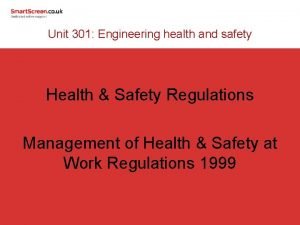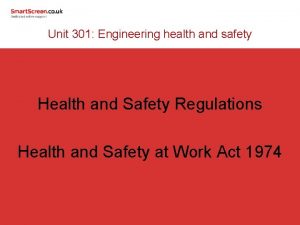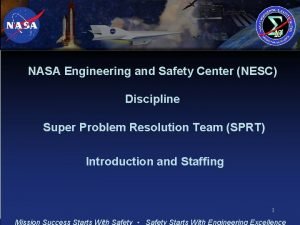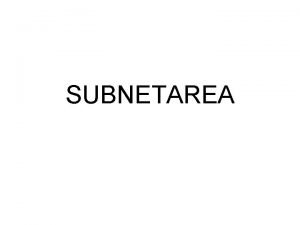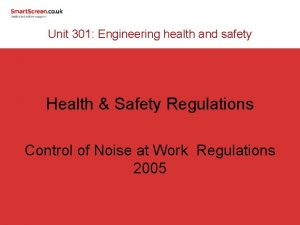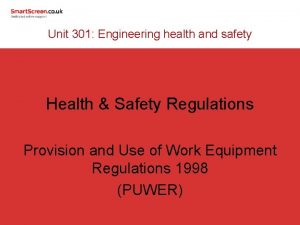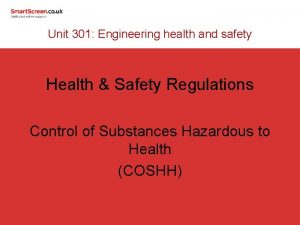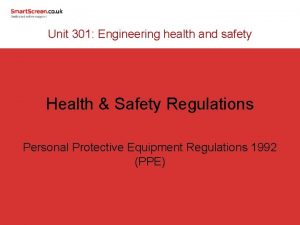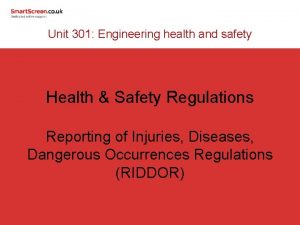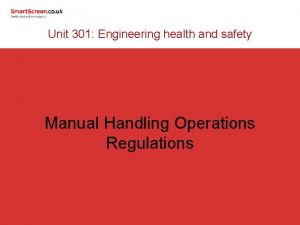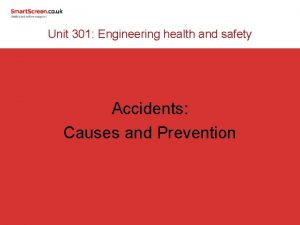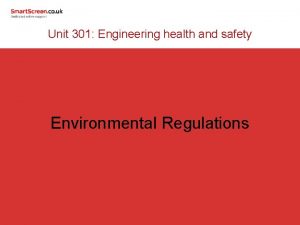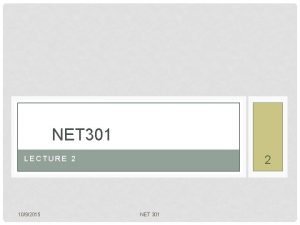Unit 301 Engineering health and safety Health and
















- Slides: 16

Unit 301: Engineering health and safety Health and Safety Regulations Health and Safety at Work Act 1974

Health and Safety at Work Act (1974) • This is the principle piece of legislation governing health and safety and is the basis of health and safety law in the UK. Its main aim is to: • ensure the safety of people when in work • protect the safety of people that may be affected by the work of others. • ensure the safe keeping, use and disposal of dangerous substances • controlling the emissions of substances into the atmosphere.

Health and safety law can be either: Criminal law: Enforces a code of conduct, usually to protect. The state can punish when breaches have occurred. Civil law: Allows an individual who has suffered harm to gain compensation or seek an injunction to prevent further harm. Two sources of law define codes against which behaviour can be judged: Common law: not written down but developed by courts over time Statute law: is written down. Failure to comply is normally a criminal offence.

Health and Safety at Work Act (1974) • The Health and Safety at Work Act (1974) generally allows employers to decide how to control any identified risks. • Guidance and approved codes of conduct (ACOP) give advice on ways of addressing risks. • Some risks are so great that requirements for their control are specified within regulations. • Regulations are law, approved by parliament.

Regulations are laws usually made under the Health and Safety at Work Act (1974) (HASAWA). These include: • Control of Substances Hazardous to Health (COSHH) • Provision and Use of Work Equipment Regulations (PUWER) • Electricity at Work Regulations • Reporting of Injuries, Diseases, Dangerous Occurrences Regulations (RIDDOR) • Management of H&S at Work Regulations • Personal Protective Equipment at work regulations (PPE) • Noise at Work Regulations • Control of Major Accident Hazards Regulations (COMAH)

‘So far as is reasonably practicable’ • • • The term ‘so far as is reasonably practicable’ (SFAIRP) is used within HASWA regulations. The Health and Safety at Work Act 1974 (HASWA) imposes a duty on employers to ensure, so far as is reasonably practicable, the health, safety and welfare at work of all their employees. Employers will need to demonstrate that they are reducing risk so far as is reasonably practicable. To decide if a risk has been reduced so far as is reasonably practical involves assessing the risk to be avoided and compare this with the time, money and trouble taken to reduce this risk. An employer would not be expected to completely eliminate all of the risks that employees are exposed to. It would be impossible to remove all of the risks all of the time.

‘So far as is reasonably practicable’ ‘. . . in every case, it is the risk that has to be weighed against the measures necessary to eliminate the risk. The greater the risk, no doubt, the less will be the weight to be given to the factor of cost. ’ Edwards v The National Coal Board Which of these examples would be considered SFAIRP? Spending £ 1 million to prevent 5 people bruising their knees? Spending £ 1 million to prevent a major explosion that may kill 150 people?

Health and Safety at Work Act (1974) • General Duties for Employers to: • Employees • Members of the Public • General Duties for Employees to: • Themselves • Others ‘So far as is reasonably practicable’

Employers’ responsibilities • • • Provide a safe place to work Provide safe plant and equipment Provide a safe systems of work Provide a safe working environment Provide and maintain work equipment Provide safe methods of handling, storing and moving goods and materials • Provide any PPE required to safely undertake a task • Consult with employees, or their representatives, on H&S matters

Employers’ responsibilities • Provide welfare facilities • Protect others (non-employees) that may be affected by any work undertaken • Ensure safe storage, use and disposal of dangerous substances • Provide a system for reporting accidents • Provide training, information, instruction and supervision to enable an employee to complete a task safely • Provide a Health & Safety policy

Employees’ responsibilities • To take care of their own health and safety. • Protect others that may be affected by their work activities. • Cooperate with employers on health and safety. • Use any PPE provided by the employer. • Do not interfere or misuse equipment provided for your health and safety.

Employee safe practices Maintaining a safe working environment can be supported by safe working practices: • • Be alert Maintain personal hygiene Know emergency procedures Report all hazards

Health and safety enforcement • Health and safety is enforced in the UK by the Health & Safety Executive (HSE) • Local authorities can enforce health and safety law in premises allocated to them • Railway enforcement is the responsibility of the Office of Rail Regulations (ORR) • HSE inspectors and Environmental Health Officers have various powers related to the enforcement of health and safety

HSE Inspectors Under Section 20 of the Health and Safety at Work Act inspectors have a number of powers: • Enter any premises for the purpose of enforcing H&S law • Order areas to be undisturbed, take photos, measurements and samples or take possession of articles or substances that may cause harm • Require the production of relevant documentation • Impose improvement notices • Impose prohibition notices • Initiate prosecutions • Ultimately, the HSE inspector can close down a company with no notice if it is considered a serious danger

Environmental Health Officers Responsible for protecting public health Incident types: • • • Air pollution from factories Chemical disposal into waterways Illegal waste dumping Restaurant hygiene Noise pollution Pest infestation

Any questions?
 Four cs health and safety
Four cs health and safety Health and safety regulations in engineering
Health and safety regulations in engineering Unit 6 review questions
Unit 6 review questions Nasa engineering and safety center
Nasa engineering and safety center Which display mode is allowed for proper navigation?
Which display mode is allowed for proper navigation? Safety care behavioral safety training
Safety care behavioral safety training Personal safety vs process safety
Personal safety vs process safety Safety assessment for ind safety reporting
Safety assessment for ind safety reporting Basic safety construction site safety orientation
Basic safety construction site safety orientation Construction site safety orientation
Construction site safety orientation Forward engineering and reverse engineering
Forward engineering and reverse engineering Hazard based safety engineering
Hazard based safety engineering Sa se imparta nr 301
Sa se imparta nr 301 Log 2 + log 50
Log 2 + log 50 Coe 301
Coe 301 Contul 301
Contul 301 Cmnalle/301
Cmnalle/301
